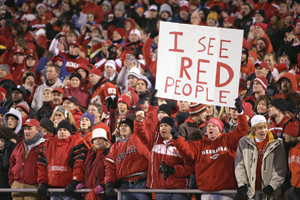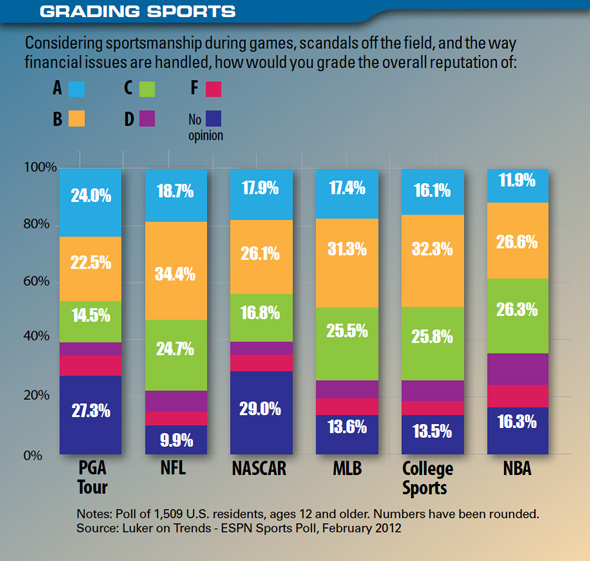Turmoil. With two labor actions, college realignment and school scandals, continuing economic hardship, and the explosion of technological innovation, one might think American sports are in a state of turmoil. But for as much as things are changing, the strength of the love of sports remains.
The fan-base sizes of the affected sports have held close to or exceeded their numbers from recent years, according to nearly 20 years of trending data from The ESPN Sports Poll. That consistency, however, is not the story here. It just led us to conduct new research of sports turmoil to see if there were any noticeable impacts. The findings revealed some surprising trends regarding fans’ connection to sports.
■ Only 43.8 percent of Americans ages 12 and older “… are aware of the recent realignment of college sports conferences where teams are moving from one conference to another.” (ESPN Sports Poll, February 2012; random landline/cellphone sample of 1,493 in the U.S., ages 12 and older.)
FORWARD THINKING
With …
DAVE BOECK
ASSOCIATE PROFESSOR OF ARCHITECTURE,
UNIVERSITY OF OKLAHOMA
■
As an avid Oklahoma fan, how has the loss of Nebraska from the Big 12 affected you?
“I admit: One of the reasons I came to OU decades ago was the strength of the sports traditions. At first, there was a feeling around here of losing a family member. Now, it’s like the focus has shifted from the big rivalries to winning another national championship. There is as much passion, just a different focus.”
Among college football and basketball fans, the percent aware wasn’t much better (55.3 percent), and avid college sports fans were still underwhelming at 70.9 percent.
It gets better. Next, we asked those who were aware: “Have you been following the realignment closely?” Just 26.6 percent of Americans who were aware said Yes. Among the college fans that were aware, 29.4 percent said Yes, and 42 percent of avid fans were following it closely.
That much turmoil doesn’t matter? We broke the analysis down to look at differences for those whose favorite team was in one of the more-affected conferences, such as the Big 12. Those fans were only marginally more aware and following more closely than those favoring teams from less-involved conferences. The college fans that do not have a favorite team were, as expected, the least aware as a group (29 percent), which raises the question: Can you be a fan and not have a favorite team? Turns out, the answer may well be yes. That may signal a dramatic change in the context of sports interest in America. More on that in a bit.
So, there has been turmoil in sports, but fan-base sizes are holding. And in the case of college sports, dramatic change in realignment is largely out of sight. When in sight, it is largely ignored. Turmoil isn’t driving fans away and it doesn’t seem to be getting much of their attention.
 |
Are college fans paying attention to conference realignment? Poll results reveal not very much.
Photo by: GETTY IMAGES
|
We then asked respondents to give a general, school-type grade to each of six major sports to see if change and turmoil are affecting their current overall reputations. The question was: “Considering sportsmanship during games, scandals off the field, and the way the sports handles their financial issues, how would you grade the overall reputation of … ?” Respondents were able to assign grades of A, B, C, D or F. The chart (above) shows the percentage of Americans 12 and older for each grade and the percentage who said “they don’t know.” Every sport got at least 90 percent passing grades and at least 35 percent in the A/B range. Looking only at those who had an opinion, every sport had at least 78 percent average or above (A-C) grades. They all passed.
If there is turmoil in the world of sports, it’s not enough to:
• send fans away;
• keep them focused on the changes; or
• get them to grade down the general reputations of the sports most affected by the turmoil.
That said, there was another very interesting finding in the grading …
■ The highest grades for the sports were given by the youngest people. And if a person was a fan but didn’t have a favorite team in a sport he or she was grading, it was a higher grade than from someone who had a favorite team. (ESPN Sports Poll, February 2012; random landline/cellphone sample of 1,493 in the U.S. ages 12 and older.)
We may be seeing an undercurrent here. Having a favorite team implies some sort of a personal connection to the sport, a bond, a reason to follow. The younger you are, the less likely you are now to have a favorite team. And yet, the direct interest in the sport remains high in ways that for nearly 20 years have predicted valued fan behavior. What’s changing?
I’m a Michigan guy. I am also not a kid. If Ohio State went to the Big 12, I would be crushed. My Michigan bond would be wounded. I’d still be a Michigan guy, but a part of me would die if they left. So I talked with Dave Boeck, a professor from the University of Oklahoma who has that direct experience in losing Nebraska to the Big Ten, and asked him what died (see Forward Thinking, above). He lost tradition, he said, but the stadium is still full, and the bigger issue now is winning national titles, not specific rivalries.
This much seems clear: The tracking data from The ESPN Sports Poll along with the new research on direct impact of turmoil indicates that if the quality is on the field, the sport will be fine. Everything else is a sideshow, and fans aren’t so interested.
While we in the industry pay close attention to every change and challenge, it’s possible that fans are coming to sports more like “American Idol” or “Survivor” where, at the beginning of each season, they can pick a side, watch the action, and change the channel to the next thing when it’s over.
Are you good with that?
Rich Luker (rich@lukerco.com) is the founder of Luker on Trends and The ESPN Sports Poll.

| FUTURE FIVE |
| The economy is still top of mind, but experiential issues -- technology and attendance trends -- are not far behind as expected hot topics in the second quarter.
|
| Rank (Pvs) |
Issue |
Score (% of first-place votes) |
| 1 (1) |
State of U.S. economy |
225 (36) |
| 2 (3) |
How financial pressure companies feel will affect sports investments |
182 (14) |
| 3 (2) |
Ability of middle-income American families to spend money on sports |
181 (11) |
| 4 (4) |
Competition sports faces from tech and entertainment marketing |
164 (4) |
| 5 (6) |
The trend in attendance at professional and college sports events |
155 (17) |







